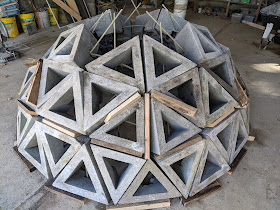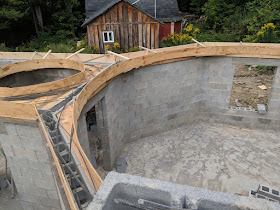Here are the basic steps to assemble a first frequency truncated icosahedron from 'pent' and 'hex' concrete block, as provided by Spherical Block. Trace out a circle of radius 3 ft. 1 inch. Arrange the block in a five-fold, or pentagonal pattern, one pent, two hex, [repeat 5X]. Arrange all blocks with tips pointing up.
Next, place blocks with tips pointing down, two pent, one hex, [repeat 5X]. FRP, Fiber Reinforced Plastic rebar is used here, #3, or 3/8 inch diameter. Rebar is 8 ft. 10 inches, and goes from center hex block and is easily bent past two pent and into the next center hex, as shown.
Additional rebar is provided horizontally, as shown. Length is 41 inches. Rebar is secured with zip ties, to help align the structure.
Hex block are placed, tip pointing up, as shown.
Because this is a first frequency structure, and is made from block designed for a second frequency structure, wooden shims were used during this dry-stack assembly. This gave the blocks the increased 'wedge' required for first order arrangement. When using mortar, the mortar will be tapered for a first frequency dome; thicker outside.
Additional rebar are placed vertically, as shown, attached with zip ties. These are also 41 inches long. Additional pent blocks are placed, as shown
Two more hex blocks are placed, tips down, as shown.
An additional course of hex block are added, as shown.
Finally, 5 pent blocks are added to the top and final course. All of these block edges would be in close alignment if this were mortared together. Assembly occurs without any additional support scaffolding or centering. This first frequency dome has an outer diameter of around 8 ft.
The first frequency test was easily disassembled. A second frequency dome is now being assembled.
Here are the same basic steps, except that the radius is doubled and 4 times as many block are used. This second frequency dome has an outer diameter of around 16 feet. 2 pent, 4 hex, 5X, etc., tips up.
And so on. It is all self-supporting as it is assembled. Larger domes of higher frequencies can also be made, all from the same block.

















































